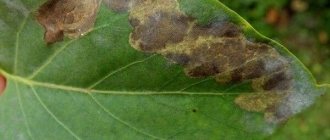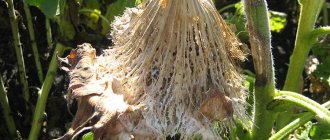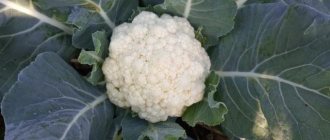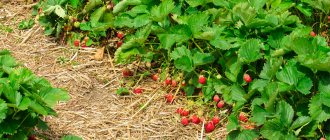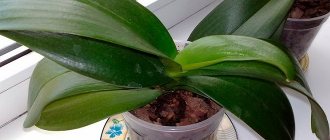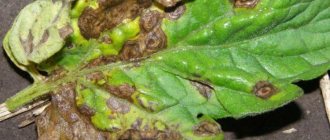Unless the cauliflower at the market is very fresh, I usually see at least a couple of specimens with tiny blackish freckles on the bumpy "flower" surface.
I assumed the stains were mold and tried to avoid them. I even shave that part of the cauliflower a little (for aesthetics) if I have a head that has them. But they don't look musty or fluffy. So I'm curious: is it actually mold or just a color change that happens as cauliflower ages?
Can you eat black spots on cauliflower?
Dear readers, do you like cauliflower? Personally, I adore her. Of all the types of cabbage, I prefer this one. After all, besides the fact that it can be prepared in many different ways and it will always be tasty, cauliflower is also very healthy. And this is exactly what we will talk about in more detail now.
Cauliflower got its name thanks to its delicate inflorescence heads, which we eat. In England, this type of cabbage is so popular that there is a proverb: “The best of flowers are cauliflower flowers.”
In our country, cauliflower is not as common as regular white cabbage, which is a pity, because nutritionists consider it the most valuable type of cabbage in terms of the content of nutrients and their digestibility. It is good for women, men, children, and even pregnant women and infants - this vegetable will be useful for everyone in their own way. Cauliflower is also used in cosmetology, folk medicine and for weight loss.
Why does cauliflower turn black? Why does cauliflower turn dark?
I love cauliflower very much and always grow it in my garden.
But for the last two years she has been sick with something. When the heads become the size of an apple, dark spots appear on the white inflorescences. The development of the head of cabbage slows down and it looks unsightly. What happened is not clear. I haven't changed the technology. My place for cabbage is bright and there is no scorching midday sun. What should I do? A.G. Chinyaeva, Yaroslavl
There can be several reasons why cauliflower turns brown. You can determine which one is “yours” by the appearance of the plant. Take a closer look at the spots on the cabbage. This will help make an accurate diagnosis.
LACK OF NUTRITION
When the pioneers explored America, they suffered from scurvy. This is a serious disease that has knocked strong men off their feet. For a long time they could not find the cause of this disease.
It turned out to be a lack of nutrition. No, there was enough food. There was just one little thing missing—vitamins.
Now we have them in tablet form. Then you just had to harvest berries: cranberries, rowan, rosehip. But this was not given due importance. What can a handful of berries do? After all, you can’t get enough of them.
Such a long digression is necessary to better understand the role of microelements in plant life. Microelements for them are the same as vitamins.
Elements such as nitrogen, phosphorus, potassium, calcium, magnesium and iron are found in plants in relatively large quantities - these are macroelements. In addition, we often add them as fertilizers, at least the basic NPK complex (nitrogen - N, phosphorus - P and potassium - K). But we often forget about microelements.
Boron, manganese, copper, zinc, molybdenum, cobalt are found in the plant in small quantities. That's why they are called microelements. But this does not mean that their role in the life of the plant is insignificant.
When there is a lack of microelements in the soil, plants experience physiological disorders, which leads to changes in appearance, reduced yield, and even death.
All these microelements are common elements in the earth’s crust, but their content varies in different soils of the country.
If cabbage was growing normally before, but has now begun to darken, this may mean that the plants have exhausted the supply of microelements (in particular boron) in the soil.
WHAT TO DO?
Chemical composition of cauliflower
Cauliflower has a very rich vitamin and mineral composition and belongs to the group of the most healthy vegetables. Among the vitamins, it contains ascorbic acid, a wide range of B vitamins, which are very important for the body: B1 (thiamine), B2 (riboflavin), B3 (pantothenic acid), B6 (pyridoxine), B9 (folic acid), as well as PP vitamins ( nicotinic acid), E, K, H (biotin), choline and the rather rare vitamin U.
If we compare cauliflower and white cabbage in terms of vitamin C content, then the latter contains 1.5-2 times less.
50 g of cauliflower inflorescences provides our body’s daily need for vitamin C, 100 g – for B vitamins.
It contains a lot of macro- and microelements: calcium, magnesium, sodium, potassium, phosphorus, iron, zinc, copper, manganese, selenium, as well as cobalt, iodine, chlorine. As for iron, cauliflower contains twice as much as green peas, peppers and lettuce.
Cauliflower is rich in protein: compared to white cabbage, it contains several times more protein. Based on this, inflorescence heads can serve as a good replacement for animal protein. Probably due to this quality, some nutritionists call cauliflower white cottage cheese.
In addition, cauliflower contains tartronic, citric, malic acids, delicate dietary fiber, pectin, enzymes and other substances important for the health of our body.
How to treat cauliflower against pests and diseases
To preserve the cauliflower harvest and effectively protect it from diseases and parasites, you need not only to properly organize the care of the crop, but also to take a responsible approach to the choice of means and preparations for processing.
Most often, gardeners use popular and affordable means:
- To overcome bacterial diseases and prevent them, the soil is treated with a solution of colloidal sulfur 0.4% (average consumption 5 g per 1 m² of plot).
- Fungal diseases can be successfully overcome through the use of fungicidal agents. Most often, 1% Bordeaux mixture is used for spraying beds. In addition, the biological product “Fitosporin” is widely used for treating soil and seeds, according to the attached instructions.
- When controlling pests, industrially produced insecticides are usually used to spray the plant and soil. The most popular remedy among gardeners is the drug "Bankol", a universal insecticide with a wide spectrum of action. The solution is prepared in accordance with the manufacturer's instructions.
- You can't ignore folk remedies either. For example, a strong solution of laundry soap (100 g of soap per 1 bucket of water) is perfect for killing aphid larvae or other insects. To overcome infectious diseases, the soil is limed by adding ash at the rate of 2 kg of ash per 1 m² of planting).
You will be interested to know about the features of growing broccoli.
So, the main diseases and pests that affect cauliflower were described above. This allows us to conclude that this plant is susceptible to a large number of diseases, but the method of combating them comes down to strict adherence to agricultural cultivation techniques, control and application of standard preventive measures, such as high-quality soil care and regular inspection. Following these simple rules will help you avoid problems and harvest a rich harvest of healthy vegetables at the end of the season.
Health Benefits of Cauliflower
Thanks to its rich composition, including rare substances and microelements, cauliflower has a beneficial and healing effect on many organs and systems of our body.
Cauliflower for the heart and blood vessels
Cauliflower is used to treat and prevent many cardiovascular diseases. It not only helps cleanse the blood of existing cholesterol deposits, but also prevents their formation. Therefore, experts have assessed the benefits of cauliflower for atherosclerosis as a therapeutic and prophylactic agent.
Cauliflower also strengthens the walls of blood vessels, normalizes the balance of blood clotting, and improves blood circulation. And, as a result, regular consumption of cauliflower is a good prevention of heart attacks and strokes.
The inflorescence heads are also useful for the heart, as they support normal heart rhythm.
Often people susceptible to cardiovascular diseases suffer from edema. Thanks to the potassium contained in cauliflower, the problem of removing excess fluid from the body and normalizing the water-salt balance is solved.
Cauliflower for digestion
The benefits of cauliflower for the gastrointestinal tract are great. Its fiber is very gentle, does not irritate the stomach, unlike white cabbage, and is also well digested and absorbed by the body. Therefore, doctors recommend consuming cauliflower for gastritis and other problems of the digestive system.
Pink coating on cauliflower. Post navigation
Cauliflower is susceptible to various harmful diseases and pest attacks. Most often they appear when the rules of agricultural technology and crop rotation in the country are violated. Some diseases of cultivated cauliflower (here is an article about it) actively develop under bad weather conditions, and to prevent attacks on vegetables by pests, it is imperative to take preventive measures.
Description of the signs of cauliflower diseases, treatment and control of them
Mucous bacteriosis
The disease affects plants when moisture cannot reach the level of the absorbing roots. This happens due to improper water regime. Watery spots appear on cauliflower heads. Over time, the diseased part of the vegetable head can turn into rotten tissue with an unpleasant odor. The disease progresses most quickly in humid weather.
Fight them
When putrefactive spots appear on cauliflower, carefully cut them out with a sharp knife, including unaffected tissue. We tear out heavily infected specimens and burn them. In the spring, at the dacha, we disinfect the soil with a 0.4% suspension of colloidal sulfur (5 g/1 sq. m.). After harvesting, we destroy the remains of the plants.
Blackleg
Seed sprouts and young seedlings are susceptible to this disease. The root collar and base of the stem turn black and soften. In this case, the cauliflower dies.
Treatment
We comply with the conditions of agricultural technology and crop rotation of vegetables. We buy seedlings from trusted sellers. We disinfect the soil with steam or formaldehyde solution. We treat the seeds with Pseudo-bacterin-2. We disinfect cauliflower seedlings twice with Previkur 607 SP. We immediately destroy plant specimens with symptoms of this disease.
Mosaic
With this viral disease, spots of various shapes and colors appear on cauliflower leaves. The leaves take on a boat shape and wrinkle.
How to fight
We promptly combat sucking pests that weaken the plant and transmit this virus. We regularly inspect cauliflower plantings in the country for the presence of disease. We destroy the affected vegetable specimens, since they are practically untreatable.
Alternaria blight
Brown spots appear on cauliflower leaves and their edges darken. Concentric circles appear on plants affected by this fungal disease.
How to treat
We sow only quality seeds, which are previously disinfected with disinfectants (Planriz, TMTD). We treat vegetative plants with sulfur- and copper-containing preparations (colloidal sulfur, copper sulfate, Bordeaux mixture). We add vegetable fertilizers to the soil in moderate quantities.
Kila
A fungal disease affects the roots of cauliflower. At the same time, swellings and growths form on its roots, growing to large sizes. Over time, they begin to rot and collapse. Plants wither, turn yellow and dry out.
Fight her
Throughout the growing season, we periodically add crushed wood ash to the soil for vegetables. After this disease, we do not grow cauliflower in an infected area for 5-7 years. We fertilize country plantings with two-year-old humus. When planting seedlings, add a little fluff lime to each hole. Periodically we carry out root watering with a solution of dolomite flour (1 glass of flour per 10 liters of water).
Downy mildew (peronospora)
With this fungal disease, yellowish spots with a white coating appear on cauliflower leaves. Affected plant leaves die over time. Thickened plantings are much more susceptible to this disease.
Treatment
Before sowing, heat the vegetable seeds for 20 minutes in warm water (50 degrees). Spray the cauliflower beds with 1% Bordeaux mixture or 0.4% polycarbocin.
Description of the signs of insect pests of cauliflower, how to fight
Cruciferous flea beetles
In hot weather, small insects appear on young plants and feed on their tissues.
How to deal with them
Spray the seedlings with a 0.2% solution of trichlorometaphos-3. After 10 days, we repeat the processing of vegetables.
Cabbage fly
Pests lay eggs on plant stems at ground level in summer. Their larvae infect the root. Affected cauliflower grows poorly, loses yield, and sometimes dies.
How to choose cauliflower. What to pay attention to
We looked at the benefits of cauliflower. But how to choose it correctly so that it contains the maximum range of useful and medicinal substances?
When choosing cauliflower, the most important thing is its freshness, since after harvesting it retains its beneficial properties for only 10 days. Therefore, pay attention to the following points:
- the head of cabbage should be heavy and dense;
- the inflorescences are surrounded by fresh green leaves that tightly fit the head of cabbage. Often, in order to hide the long shelf life of cabbage, sellers tear off yellowed leaves that have begun to fade;
- inflorescences can be white, grayish or ivory. There are varieties with green and even purple inflorescences;
- pay attention to the inflorescence heads: if they have brown spots or black dots, this is a sign that the product has begun to deteriorate;
- also a sign of long-term storage of cabbage is the pronounced yellow or brownish-yellow color of the inflorescences;
- the inflorescence heads should fit tightly to each other.
Description of the signs of insect pests of cauliflower, how to fight
Cruciferous flea beetles
In hot weather, small insects appear on young plants and feed on their tissues.
How to deal with them
Spray the seedlings with a 0.2% solution of trichlorometaphos-3. After 10 days, we repeat the processing of vegetables.
Cabbage fly
Pests lay eggs on plant stems at ground level in summer. Their larvae infect the root. Affected cauliflower grows poorly, loses yield, and sometimes dies.
Fight her
We compact the plantings at the dacha with celery. Water the soil around the root with a 0.2% solution of karbofos (200 ml). We perform this processing of vegetables 3 times with a break of 8-10 days.
Cabbage aphid
Damaged cauliflower leaves lose their color and curl. The plant cannot form a full head.
How to fight
Since pest eggs are perfectly preserved in weeds and plant debris, we destroy them in a timely manner.
Stem stalker
The pest damages cauliflower seedlings. The insect gnaws holes in the leaves and skin of the petioles and eats away soft tissue. Bulges form at this location. The larvae damage the cabbage head.
Fight them
We destroy weeds and plant debris. Several times during the season we spray dacha plantings of vegetables with 0.2: a solution of karbofos, trichlorometaphos-3. The interval between treatments is 8-10 days.
Butterflies (cabbage cutworm, moth, white butterfly)
The eggs of these pests are located on the bottom of the leaf. Hatched caterpillars damage cauliflower leaves. Adult caterpillars crawl inside the head, damage it and pollute it with their excrement.
Ways to fight
We regularly inspect the leaves and if we detect a clutch of pest eggs, we destroy them by hand. We collect caterpillars by hand. We spray the plants with the microbiological 0.5% preparation Entobacterin-3. Spray the vegetables 2-3 times with 0.5% potassium chloride, 0.1% superphosphate extract. We spray cauliflower with infusions of black henbane, datura vulgare or creeping bitterweed, which repel flying pests.
The knowledge we have gained more than helps us to guarantee a good harvest of cauliflower, but making delicious dishes from it, simply pickling it or making it according to a universal recipe will not work.
How to store cauliflower
Cauliflower should be stored on the bottom shelf of the refrigerator, in a vegetable container, stem side down, preferably separately from other foods. In this form, the inflorescences will not absorb moisture. If fresh cabbage was purchased, the shelf life is 7 days. If for some reason you purchased the inflorescences separately, try to consume them within two days.
Cauliflower can be consumed out of season for health benefits. Properly frozen cabbage fully retains its beneficial and medicinal properties, so if the question is whether imported cauliflower is fresh or frozen, the answer is clear - frozen. Think about the distance fresh cauliflower has traveled from its place of growth to our store or market, and yet the benefits of cauliflower last only 10 days!
Pests affecting crops: signs of parasitism and control methods
Various insects and slugs love to feast on cauliflower growing in the garden. Proper crop rotation, deep digging of ridges, weed control - all these works are preventive measures and reduce the number of pests. If they do appear, then they use repellents, agricultural techniques or destroying drugs.
Gnawing owl
Large brownish larvae (caterpillars) live in the top layer of soil in spring. They gnaw at the base of the stem of planted cabbage seedlings. Plants break, fall and die.
Control measures:
- Deep digging of the soil in autumn and spring.
- Combined planting of cauliflower with hyssop, sage, snapdragon.
- Planting seedlings as early as possible.
- Watering young bushes at the root with the biological product Fitoverm.
- Manually digging out caterpillars from holes with dead plants.
Spring cabbage fly
An inconspicuous fly lays white eggs (1 mm in size, in groups) near the root collar of planted cabbage seedlings. Soon, light-colored larvae hatch, secretly penetrate into the roots of the cabbage, feed and grow to a size of 0.8 cm. After a month, they go into the ground and pupate. One cabbage plant can be parasitized by 2 to 300 larvae. Damaged bushes are stunted and wither; the leaf turns bluish-gray.
Control measures:
- Digging beds in the off-season.
- Combined planting with celery and basil.
- Laying out repellents (wormwood grass, tobacco dust) around the planted bushes.
- After planting cabbage seedlings, apply chemical pesticides with diazinon (Pochin, Zemlin, Muhoed) to the root zone.
- The last resort (in case of severe infection) is to water the plants at the roots with Karbofos or Alatar.
Cruciferous flea beetles
Small (2-3 mm) jumping bugs attack young cabbage in hot, dry weather, preferring plants up to the 5th true leaf. Insects gnaw holes in the leaf blades, retarding the growth of bushes (sometimes causing their death).
See also Treatment and protection of cabbage from slugs and snails
Control measures:
- Combined planting with onions and garlic.
- Water the cabbage by sprinkling, followed by dusting with sifted wood ash or tobacco dust.
- Irrigation of plantings with herbal infusions of insecticidal plants (dandelion, tomato tops).
- In critical cases - treatment with chemical insecticides (Alatar, Inta-Ts-M, Karbofos).
cabbage aphid
Colonies of small (about 2 mm) grayish or greenish individuals suck juices from cabbage leaves. Plant tissues become pale or purple, bluish. Leaf plates become deformed and wither. The bushes are depleted and lag behind in development; the heads are practically not tied.
Control measures:
- The most effective treatment of emerging aphids is with biological insecticides (Fitoverm, Biokill, Iskra Bio).
- You can use store-bought preparations such as Dachnik (based on fir oil), Green soap.
- Sometimes folk remedies help - herbal infusions (tobacco, onion, garlic, tomato, etc.), a solution of pine concentrate for baths.
- It is recommended to combine planting cauliflower with onions and tomatoes.
Caterpillars and larvae (worms)
Cauliflower foliage is damaged by caterpillars of various butterflies (white moths, cabbage moths, cabbage moths, etc.), and sawfly larvae. Insects eat the leaf blades, and the plants become depleted. The development of bushes and the formation of inflorescences is delayed. Pests also feed on formed heads. Fortunately, caterpillars can be effectively controlled without chemical pesticides.
Control measures:
- Joint planting of cauliflower with basil, celery, marigolds.
- Regular manual collection of pests.
- A folk remedy is to spray plants with a solution of ammonia (50 g) and table salt (2 tbsp) in a bucket of water.
- Treatment of cabbage with infusions and decoctions of insecticidal herbs (henbane, tomato, burdock, wormwood, hot pepper pods).
- Spraying of plantings with biological preparations (Bitoxibacillin, Lepidocid, Fitoverm).
Slugs
These mollusks harm cauliflower throughout the season, giving rise to several generations. They are most active in rainy weather. There is a risk of losing a significant part of the harvest. Slugs quickly eat the leaves and heads of cauliflower, and at the same time eat the marigolds growing nearby. Traditional insect repellents do not work on shellfish.
Control measures:
- Manual collection of pests from under traps (boards, rags, etc. laid out in beds).
- Mulching the soil with pine needles, sawdust, crushed eggshells, coarse sand, and dried nettle tops.
- Regular dusting of the surface of the beds with wood ash, slaked lime, crushed superphosphate, and ground red pepper.
- Lure with beer poured into plastic bottles placed on their sides.
- You can spray cabbage plants with ammonia (2 tablespoons per 5 liters of water).
- Among the chemical pesticides against slugs, preparations with metaldehyde (a poisonous bait) are used - Thunderstorm, Slug Eater. Rain-resistant granules are sprinkled on cauliflower beds.
How to cook cauliflower
Cauliflower is prepared in a variety of ways, including eaten raw in salads. For the winter, in addition to traditional salads, it is also salted and pickled. When properly prepared, it retains most of the nutrients. At the same time, the vegetable contains a large amount of valuable, but water-soluble substances, and if we cook it in a large amount of water, then most of them go into the broth. Therefore, such vegetable broth cannot be poured out - be sure to prepare something based on it.
The best way to preserve most of the beneficial properties of cauliflower is to steam the flower heads or in a small amount of water. Also, professional chefs for these purposes advise using mineral water instead of ordinary water or adding a little sugar. It is important not to overcook the cabbage - usually it is enough to cook it for 5 minutes after boiling. If you try to pierce the florets with a fork, they should not be too soft.
To preserve the benefits of cauliflower, it is also not recommended to cook it in aluminum dishes.
How much cauliflower can you eat per day?
Adults who do not suffer from serious chronic diseases and have no contraindications can consume cauliflower without restrictions - the only important thing here is to listen to your body.
During pregnancy, it is better to start eating cauliflower with a minimum amount (50 g) and, depending on how you feel, gradually increase the portion. Frequency – 2-3 times a week.
Nursing mothers can include cauliflower in their diet as early as 3-4 weeks after giving birth. You should also start with a minimum amount, the maximum amount per day should not exceed 200 g.
Pediatricians usually advise introducing cauliflower into complementary foods for babies from 4-5 months, starting with 1/4-1/2 tsp. per day. Be sure to monitor your baby's well-being throughout the day. Frequency of use: 1-2 times a week.
For people suffering from gastritis or stomach ulcers, the maximum amount of cabbage per day is 100-150 g.
Preventive measures that gardeners should take
To prevent the death of cauliflower, all gardeners need to take note of preventive measures. They should always know how to treat or spray a given crop.
It is necessary to plant in the garden those varieties that are least susceptible to various diseases and have strong immunity. These varieties will not be afraid of aphids, slugs, and caterpillars. To prevent the spread of aphids, caterpillars, and fungal diseases, you need to know what to spray with this or that product. The peculiarity of white cauliflower is that its infections are transmitted not by seeds, but through harmful insects and soil.
This is why careful cultivation of the land is so important. It needs to be loosened more often, weeds must be removed, and the types of larvae in the ground that need to be burned should be monitored. Do not forget to inspect the foliage of cauliflower as often as possible. It is always easier to prevent the onset of a disease than to throw away spoiled fruit later.
Every gardener should know about diseases and pests of cauliflower. If you process the plants correctly, the cabbage becomes protected from environmental influences. And then an excellent harvest and wonderful, delicious dishes from this vegetable are guaranteed.
Harm of cauliflower and contraindications
Cauliflower is a valuable food product that has a great impact on our health. In order for its use to bring only benefits, one should take into account the possible harm of cauliflower, and it has many contraindications. This:
- dysentery;
- stomach upset;
- intestinal spasms;
- acute enterocolitis;
- increased levels of uric acid in the body (gout);
- kidney stone disease;
- thyroid diseases;
- the period after surgery in the chest or abdominal area.
Caution should be exercised when consuming cauliflower if you have diseases of the kidneys and urinary system. Although there is a claim that cauliflower helps normalize high blood pressure, in case of hypertension and serious heart pathologies, before you start consuming it, it is better to consult a doctor you trust.
Cauliflower is recommended for the treatment of stomach and duodenal ulcers, but it should be used with caution in these diseases, as well as in case of increased acidity of gastric juice, since eating cabbage in large quantities helps to increase it.
Main diseases of cauliflower, signs and treatment
Many diseases of cruciferous crops cannot be treated, so it is important to learn how to identify them at an early stage. This knowledge will help the gardener act correctly and preserve plants that are not yet infected with infections.
White rot
Symptoms of white rot of cauliflower in the garden are quite difficult to notice. Usually they begin to appear already during storage of the heads. They form a characteristic light fluffy coating with black dots called sclerotia. Then the heads of cabbage begin to rot, and the infection spreads to vegetables lying in the neighborhood.
Rot on cauliflower
The causes of fungal infection are injury to heads of cabbage, damage by pests, and weather conditions. White rot occurs at high humidity and low air temperature.
How to avoid developing the disease:
- do not apply nitrogenous fertilizers at the end of the growing season;
- fight cabbage pests;
- harvest before frost sets in;
- 3 weeks before harvesting, reduce watering;
- Only remove whole heads without signs of damage for storage, and disinfect the room in advance.
Gray rot
This disease is also caused by a fungus. It develops in conditions of high humidity. First of all, the infection affects the damaged parts of the plant. Gray rot can be recognized by a gray-brown coating on the leaves and heads of cabbage.
After storage, the disease quickly progresses, affecting the surface of the heads with necrosis, and later the pathogens penetrate deeper and completely destroy the inflorescences. Measures to combat gray rot are the same as for white rot.
Downy mildew
This cauliflower disease is caused by downy mildew fungi. The spread of infection is facilitated by rainy weather, and the main cause of infection is sap-sucking pests. The first symptoms of the disease are the appearance of yellow, irregularly shaped, spilled spots on the upper side of the leaf blades. If you look under the leaf, you can see spots with a white coating that resembles flour.
If signs of peronosporosis are detected on cauliflower, it is necessary to spray the diseased seedlings with a sulfur solution (50–80 g/10 l of water). Among the biological preparations used to combat fungi and prevent the spread of infection:
- Fitosporin;
- Planriz;
- Gamair.
Gamair
Blackleg
Blackleg is a seedling disease. It develops on seedlings and manifests itself in the form of darkening of the stem. After the root collar rots, the plant wilts and dies. The cause of infection is the use of low-quality planting material and neglect of the procedure for disinfecting seeds and soil before sowing.
Attention! It is impossible to cure blackleg; diseased seedlings are destroyed. To prevent neighboring plants from getting sick, it is necessary to water the soil in the seedling box with Fitosporin solution, following the instructions.
Fusarium wilt
A fungal disease develops due to insufficient watering and high soil temperatures. Early varieties of cauliflower are more susceptible to it. Symptoms of fusarium wilt on cauliflower:
- loss of turgor;
- discoloration of leaves down to the veins followed by yellowing;
- wilting and death of leaf blades;
- Dark veins are visible on the cross section of the stem or leaf.
Attention! A diseased plant may first wither on only one side. At the final stage, all the leaves fall off, leaving only the bare stem.
Fusarium wilt has no cure. Infected plants are immediately dug out of the bed along with a lump of earth, taken outside the site and burned, and the soil is generously spilled with a solution of copper sulfate. To prepare it, 5 g of the substance is added to 10 liters of water.
Kila
This is the most dangerous disease of cabbage, which affects the roots. The proliferation of fungal spores leads to the formation of growths in the form of cones and compactions both on the central rhizome and on the lateral processes. As a result, the bush cannot fully feed and absorb substances from the soil.
Signs of clubroot on cauliflower:
- growth slowdown;
- yellowing of leaves;
- ovaries are not formed;
- tilting the plant to one side;
- When examining the roots, growths of different sizes are found.
Having discovered clubroot on cabbage, gardeners immediately destroy diseased specimens by burning them. The soil must be disinfected with Fundazol or Bordeaux mixture. Plants from the Cruciferous family cannot be planted in a problem bed for 4 years, as pathogens persist in the soil for a long time. It is recommended to plant lily, goosefoot or nightshade crops in this place to clear the soil of fungus.
Attention! Clubroot develops quickly in acidic soils. To protect healthy cabbage from infection, it is recommended to water the soil under the bushes with a solution of potassium permanganate, feed the crops with lime milk and apply complex mineral fertilizer with potassium.
Mucous bacteriosis
The main reason for the development of mucous bacteriosis on cauliflower is rainy weather. High humidity promotes the growth of pathogenic bacteria. The disease causes rotting of the heads. At the same time, the inflorescences become slimy and spread a stench. Gradually, all healthy tissues soften and die.
The disease can manifest itself not only in the garden bed, but also when storing forks. In this case, there is a high risk of losing the entire crop. Heads with signs of rotting are not eaten.
Vascular bacteriosis
This disease also develops with high air humidity. Harmful bacteria enter the plant through damaged aerial parts or roots. Symptoms of vascular bacteriosis:
- on seedlings, the cotyledons become discolored, the stem becomes bent;
- on adult plants, the edges of the leaf blades turn yellow, forming a triangle-shaped pattern;
- the veins on the affected tissue become dark in color, then the leaves turn brown and die.
If vascular bacteriosis is detected at an early stage, the crop can still be saved. To do this, plants are treated with biological preparations Binoram or Planriz, following the recommendations in the instructions.
Planriz
Why do blackheads appear?
So, the main reason for the appearance of these unpleasant black dots on cabbage leaves is punctate necrosis. But other diseases - white rot, gray rot, vascular bacteriosis - can also cause an outwardly similar manifestation, subsequently changing.
Pests can also be the cause of their appearance. Sometimes easily removed black spots between cabbage leaves can be the excrement of cabbage or turnip white caterpillars living in them, which not only spoil the cabbage, leaving their waste products on it, but also eat the leaves and damage the heads of cabbage.
Let's take a closer look at plant diseases that cause the appearance of black spots.
- Spot necrosis is a disease characterized by the appearance of black spots on the inner leaves of white cabbage, which are up to three millimeters in size and may be slightly depressed. This disease appears when the heads of cabbage are fully formed, that is, before harvesting.
The reason for its appearance is the excessive application of nitrogen fertilizers. This causes a disruption in the maturation of leaf parenchyma tissues and leads to a kind of point necrosis. As a rule, such spots are subsequently affected by fungal infections, which is why their color may change over time.
During storage, the disease progresses and closer to spring, the leaves of cabbage heads are sometimes simply dotted with black dots. The disease is not initially infectious. It appears as a result of metabolic disorders due to biochemical changes occurring in vegetables.
- Vascular bacteriosis can also cause the appearance of dark spots on the leaves. It also attacks leaves, but these spots appear mainly on the petioles and veins.
- White rot. The lower leaves of cabbage, as well as the root collar, are mainly affected. As a result of the disease, the leaves become discolored in patches and become covered with mycelium.
By the beginning of harvesting, the mycelium becomes dense, and black spots of various shapes appear. The cause of this disease is also excess nitrogen in the soil and its increased acidity.
- Gray rot. Heads of cabbage become infected with it already during storage. Externally, it manifests itself in the partial covering of the cuttings of the lower leaves of the head of cabbage with grayish mold interspersed with small black dots.
How to treat the appearance of black spots
Biologists name two main reasons for the appearance of dark spots on the leaves of Chinese cabbage. These include spot necrosis and alternaria.
Point necrosis
Point necrosis is a non-infectious lesion. The disease develops due to a metabolic disorder in the plant. Point necrosis is most often caused by improper feeding, in particular the excessive application of nitrogen-phosphorus agents.
Did you know? Chinese cabbage is fermented in Korea to make kimchi. This is an ancient traditional dish that has become the hallmark of the country.
Point necrosis can be determined by a number of signs:
- the dots are depressed, round or oval in shape;
- the color of the spots is black;
- size within 1–4 mm;
- the lesion appears on the outer leaves, very rarely on the inner ones.
Often the disease begins to develop on almost ripe vegetables. If about 45–50% of the fruit is affected, spots may appear even after harvesting during storage.
Alternaria blight
Alternaria blight is an infectious disease caused by fungal spores. The main reason for the development of the disease is excess humidity. This is facilitated by excess watering and a humid climate. The infection can affect the plant even at the seedling stage. The main symptom in this case is black stripes and spots on the embryonic leaves. Often the disease develops on already developed heads of cabbage. The lesion looks like dark spots with an ashy coating.
Important! The risk zone for Alternaria disease includes Chinese cabbage plantings affected by pests.
Agronomists have different opinions regarding the dangers of Chinese cabbage with black spots. Some believe that it is enough to remove the affected leaves and wash the vegetable itself. If you heat the product, there should be no problems.
Others say it is safe to cut only leaves with spotty necrosis. This is not an infectious, but a physiological lesion that cannot harm a person. Alternaria blight poses a danger in the form of fungal spores. Such a product cannot be completely cleaned, even if the affected areas are cut off. It is better to dispose of a diseased head of cabbage.
Treatment of plantings depends on the specific disease. Pointed necrosis is a symptom of improper plant nutrition. The disease cannot be cured. You can only prevent damage by properly applying fertilizing during the growing season.
Important! Use medications strictly according to the instructions so as not to harm the plants even more.
Alternaria blight as a fungal disease is eliminated using fungicides. Among the most effective drugs for treating vegetables are Quadris, Skor and Immunocytophyte.
In order not to wonder about treatment methods, the vegetable grower needs to think about preventive measures in advance.
- These include:
- pre-planting digging of soil in the fall;
- replenishing the soil before planting with products containing elements of phosphorus, molybdenum and boron;
- planting varieties resistant to fungal infections;
- seed dressing with a 1% solution of potassium permanganate;
- planting vegetables after the “correct” predecessors, according to the rules of crop rotation;
- modern and regular watering, fertilizing, loosening the soil and weeding;
- storing the crop in a ventilated room at temperatures of 5... 7°C.
You can eat the vegetable with caution if the cause of the appearance of dots is punctate necrosis. In this case, it is enough just to cut off the alarming inclusions. It is better to avoid eating fruits affected by Alternaria. If you grow the crop yourself, then the problem can be avoided if you take the necessary precautions in time.
Is it possible to eat cabbage with black spots?
Many housewives are interested in the question: if black dots appear on cabbage, is it possible to eat it or not?
It is better not to use leaves damaged by such spots for food, although they do not pose any harm or danger to the body; it is unpleasant to do this even for aesthetic reasons.
Of course, if there is such a need, the affected leaves can simply be broken off or cut off with a knife and the remaining undamaged head of cabbage can be used for processing.
Such cabbage is no longer suitable for industrial purposes, so it should not be put on sale.
Bacterial diseases
Knowing what bacterial and viral diseases exist, you can protect cauliflower from them.
Quite often, cabbage can suffer from vascular bacteriosis. Infected cabbage has purple leaves and yellowing towards the middle of the leaf. It begins to curl, the mesh on it becomes dark lilac. If infection occurs at the beginning of ripening, then it does not allow the fruits to form. They dry before our eyes. This plant is very fragile, it dries and fades quickly. This infection is mainly caused by insects. That is why fighting both them and diseases is necessary for high-quality crop production.
If the cabbage turns purple, slimy rot with an unpleasant odor appears on it, and wet mucus appears on the foliage, then this is mucous bacteriosis. The disease occurs during the flowering period. First, the leaf is affected, it curls, darkens, and becomes covered with rotten marks. Then the disease gradually spreads to the root and head. All this is watery and smells bad. Such a vegetable cannot be eaten, so it is immediately thrown away and measures are taken to destroy the remains of the infection, that is, they treat the soil. It is necessary to monitor for pests: flies, aphids. Since they can also participate in the transmission of the virus. Alirin and Gamair are the best remedies for this disease. You can also spray with copper sulfate for prevention.
Prevention and treatment
Spot necrosis appears on cabbage leaves due to disturbances in plant nutrition during growth and ripening. This usually happens when there is too much nitrogen in the soil. Further, the development of this disease is facilitated by improper storage conditions.
To prevent the appearance of black spots on cabbage, the following conditions must be observed:
- Follow agricultural practices for cultivating crops and regulate the application of fertilizers. Preference should be given to phosphorus-potassium fertilizers, as well as those containing boron and molybdenum.
- It is also necessary to reduce soil acidity by liming or adding wood ash. These agrotechnical measures will reduce the possibility of spot necrosis on cabbage, prevent the appearance of white and gray rot, and vascular bacteriosis.
- To combat turnip or cabbage whites, you need to weed the plantings in time. When caterpillars appear, spray with a decoction of wormwood or celandine.
- Use necrosis-resistant varieties of white cabbage, such as Zimovka 1474, Amager 614, Slava 1305 and others.
- Harvesting should be carried out in dry weather. The heads of cabbage must be mature. Vegetables without visible signs of disease are stored for storage.
- Optimal storage conditions for the culture must be observed. The air in the storage room must be well ventilated. It is advisable to maintain the temperature within 0 – 1˚С, humidity 85 – 90%. Heads of cabbage during storage should be checked and if diseases of white or gray rot, as well as vascular bacteriosis, appear, remove the leaves and trim the stalk.
In conclusion, I would like to note that by strictly observing the agricultural technology of cultivating the crop and the storage conditions of the crop, the percentage of damage to cabbage heads will be significantly reduced.
Cauliflower diseases
Cauliflower is bred through selective breeding and is not found in the wild, so it is not surprising that it is highly susceptible to various diseases. The crop reacts negatively to even minor changes in the soil and does not tolerate waterlogging and violation of care rules.
White rot similar to mold
White rot is a fungal disease that occurs on already harvested crops when storage conditions are violated, in particular when humidity levels are above 80%. It's difficult to notice. White web-like formations with rare black dots appear on the surface of the inflorescences, similar in appearance to mold, and the stem and leaves are covered with mucous secretions.
Control and prevention measures:
- before planting cabbage, lime the soil;
- spray plants with copper preparations during the growth period;
- treat the premises for storing crops with a solution of potassium permanganate;
- carefully inspect vegetables before storing them and remove affected specimens;
- observe the recommended humidity (up to 80%) and air temperature (up to +1°C).
It is prohibited to eat such cabbage. Affected heads are immediately discarded.
Gray rot
The manifestation of this disease is noticeable already during storage of the harvested crop. First, gray spots appear on the inflorescences, the process of decay begins, mucus appears on the damaged surface and a cotton-like fluff forms.
Measures to prevent cabbage from becoming infected with gray rot:
- disinfect the room and container in which the crop will be stored with a solution of potassium permanganate;
- normalize the temperature (up to +1°C).
The main cause of this disease is wet and cold weather.
Kila
This is one of the most dangerous diseases for cauliflower. The causative agent is a microscopic fungus that causes deep damage to the root system. As a result, nodular formations appear in this part of the plant, metabolism is disrupted, growth slows down and the crop dies.
To prevent the spread of disease:
- Infected heads of cabbage are completely removed from the area;
- the soil is irrigated with a solution of fungicide or Bordeaux mixture;
- Weeding is carried out regularly.
If the land plot has been infected, cauliflower should be planted on it no earlier than after 5 years.
Mosaic virus
The mosaic virus spreads by transferring the sap of infected plants. A vegetable pest, aphids, is involved in this. Infection of seedlings is indicated by their stunted growth and yellowing of the stems. The leaves become spotted and fall off.
Steps to prevent the spread of the virus:
- Before planting, the seed is disinfected by soaking it for 20 minutes in hot water (up to +50°C) and drying it afterwards;
- monitor the temperature regime for seedlings (not higher than +20°C);
- affected specimens are dug out of the soil, trying not to damage the root system, and disposed of;
- observe the recommended humidity (up to 80%) and air temperature (up to +1°C);
- Weeding is carried out systematically.
The development of the disease is provoked by oversaturation of the soil with nitrogen-containing fertilizers.
Mucous and vascular bacteriosis
Mucous bacteriosis is one of the most common diseases of cauliflower. It directly affects the inflorescences and manifests itself in the form of focal rotting of leaves, which move to the head of cabbage, provoking the appearance of black spots and a putrid odor.
The problem is solved as follows:
- weed the beds regularly;
- the soil is not waterlogged;
- fight vegetable pests;
- disinfect pantries.
No less common is vascular bacteriosis, which manifests itself at absolutely all stages of culture development. It causes significant damage to the crop. External manifestations of infection of the cabbage vascular system look like this: the appearance of yellow dots along the edges of the tops, their growth towards the center, blackening of the veins. As a result, the leaves wither and crumble.
Reference. The causative agents of the disease (bacteria) are spread by cabbage flies, slugs, and bedbugs; they are transported with raindrops, stored in plant debris and in seeds for up to 3 years.
There are no effective methods to combat infection, so preventive measures are followed:
- the area from which the infected vegetables were removed is treated with a solution of colloidal sulfur (concentration - 0.4%);
- next time cauliflower is planted no earlier than after 3 years;
- the seed is soaked in the Agata-25 solution in accordance with the instructions.
Favorable weather conditions for the development of vascular bacteriosis are warm autumn with high air humidity.
Fusarium
This fungal disease is incurable, since spores that enter the soil remain active for a long time. External manifestations of infection: yellowing of the leaves is gradually supplemented by brown or brown spots, which grow over the entire area. As a result, the leaves fall off.
Prevention measures:
- affected vegetables are disposed of;
- the soil is irrigated with a solution of copper sulfate;
- follow the rules of crop rotation.
Chlamydiospores of the pathogenic fungus persist in the soil for up to 11 years. Their activation is facilitated by dry and hot weather at the beginning of the crop's growing season.
Almost everything about cabbage diseases.
Blackleg
Blackleg, or rhizoctonia, poses a direct threat to young plants and seedlings. The stem of an infected seedling becomes covered with black spots, becomes thinner and dies. Other vegetable crops are also susceptible to this disease: sweet peppers, tomatoes, eggplants, radishes, lettuce, potatoes. Therefore, cauliflower infected with black leg poses a direct threat to neighboring beds.
Measures to combat blackleg:
- treating beds with fungicide;
- preliminary soaking of the seed in a solution of potassium permanganate and pouring it into the holes after removing diseased seedlings;
- avoiding dense plantings;
- liming of soil.
The development of the disease is facilitated by growing cabbage in acidic soil, excessive moisture, lack of ventilation and dense planting.
Downy mildew
Another fungal disease of cauliflower manifests itself in the formation of a whitish coating and yellow spots on the foliage. The disease affects the seeds and stems, causing black and brown lesions to appear on them. Downy mildew significantly slows down crop growth.
They fight peronosporosis with the following methods:
- after harvesting, all crop residues and weeds are carefully removed from the beds;
- they dig up the ground;
- before planting young plants, the soil is irrigated with a fungicide solution;
- seed material is placed in hot water (no more than +50°C) for 20 minutes and in cold water for 3;
- when the first signs of the disease are detected, the seedlings are sprayed three times with a solution of ground sulfur;
- affected plants are destroyed.
If the disease has not affected the inflorescences, such a product is allowed to be eaten.
